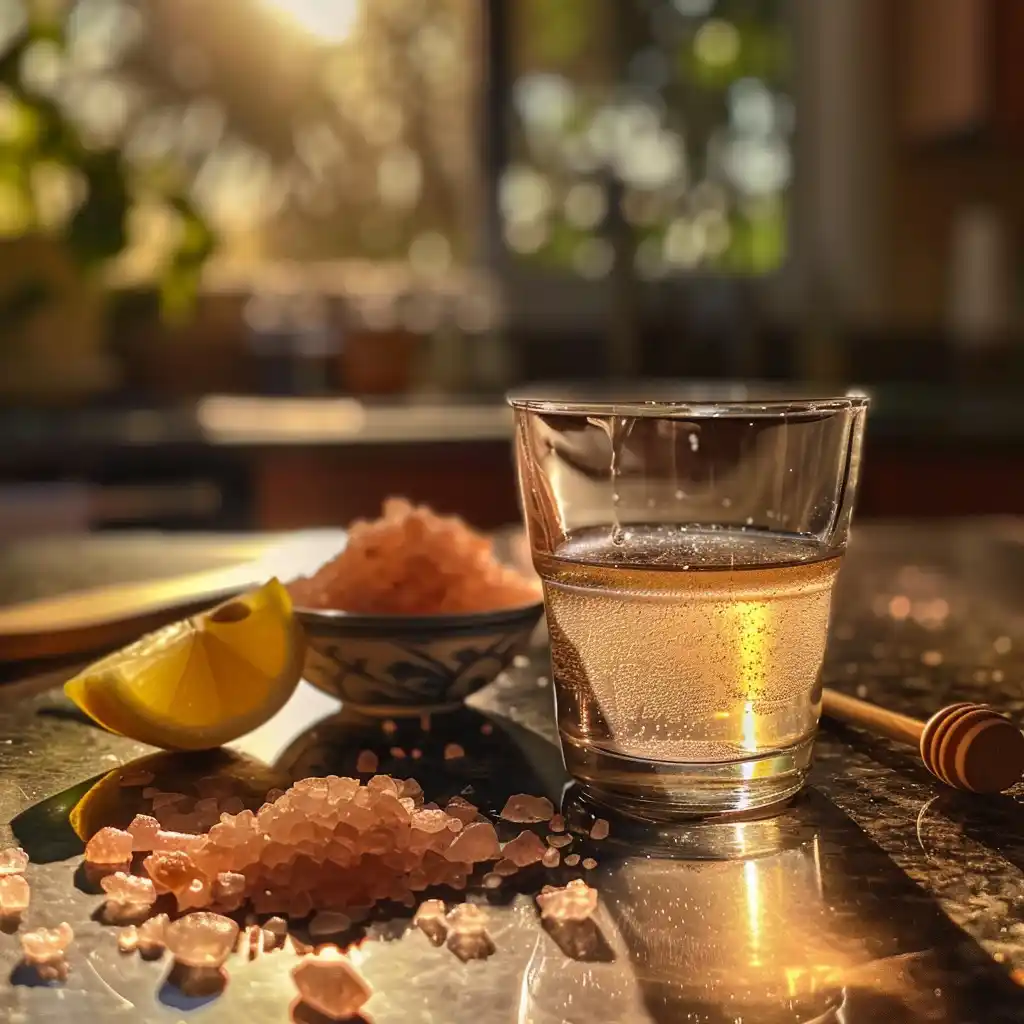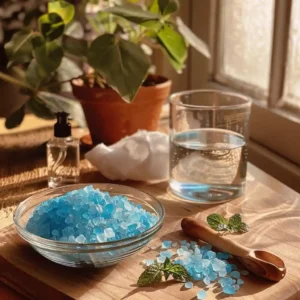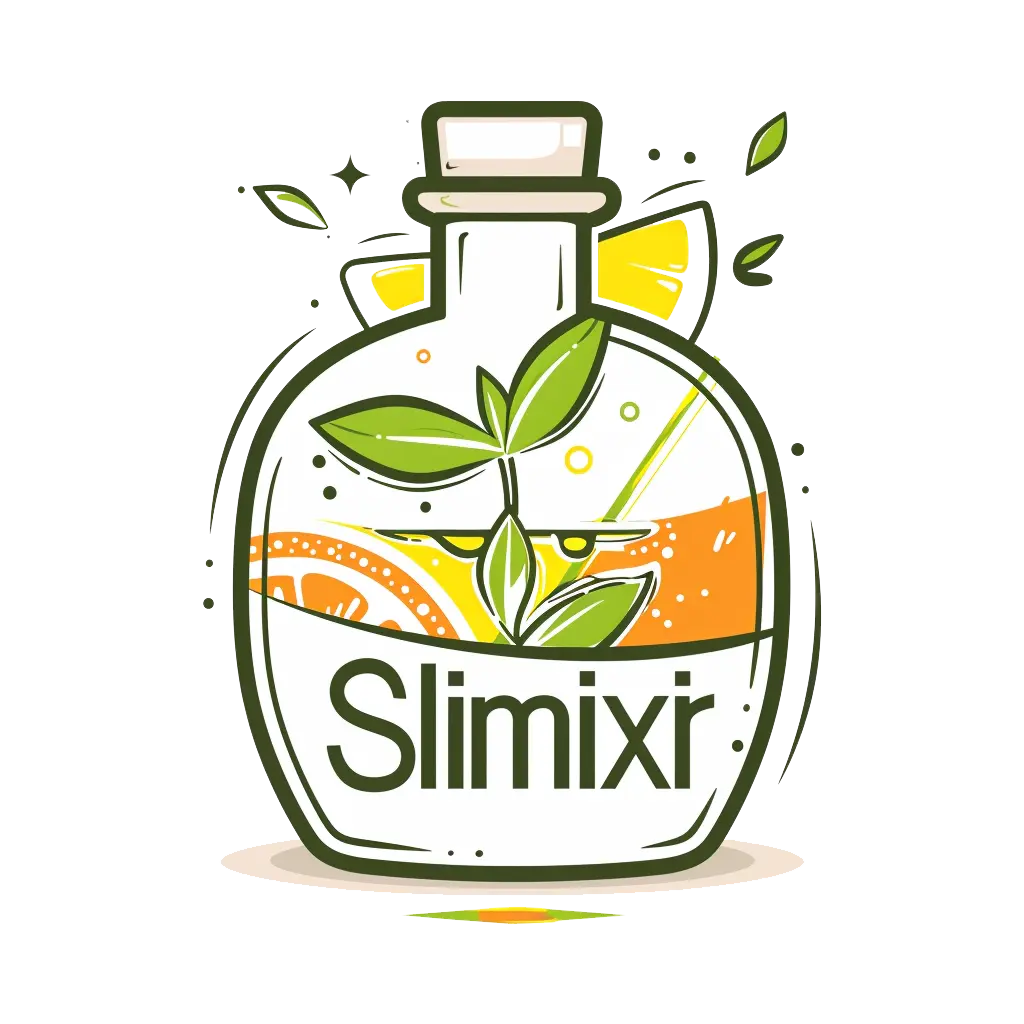Pink Tibetan salt has a story that stretches back millions of years. In this article, I’ll share what makes it so special—its origins, how it differs from regular salt, and why it’s often chosen for gentle detox routines and natural balance.
We’ll look at the traditional use of salt water before bed, the right way to mix it, and who might want to avoid it. You’ll also learn what gives it that soft, rosy color and why it feels so grounding in daily rituals.
I’ll include a few of my own evening practices and ways to bring this ancient salt into your everyday rhythm. By the end, you’ll understand how a simple pinch of this mineral can help your evenings end—and your mornings begin—with a little more calm.
Learn more about gentle cleansing habits and mineral balance in this pink salt trick recipe for weight loss, a practice that supports hydration and inner harmony.
Print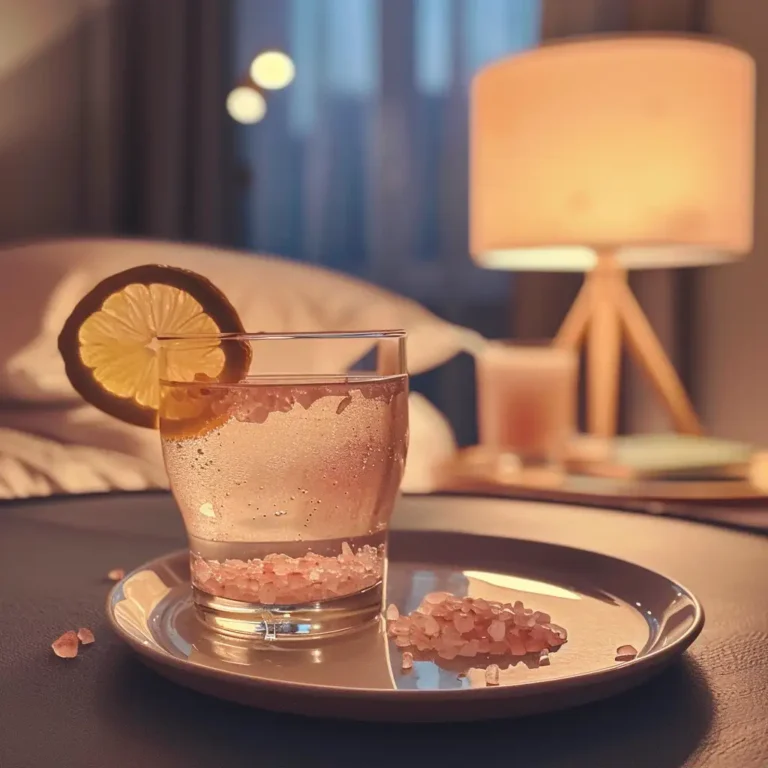
Pink Tibetan Salt: The Secret to Perfect Texture
A calming pink salt water ritual inspired by ancient traditions—supporting gentle detox, hydration, and balance before bed.

- Total Time: 5 minutes
- Yield: 1 serving 1x
Ingredients
- 1 glass (8 oz) of warm filtered water
- 1/8 teaspoon of pink Tibetan salt
- Optional: few drops of fresh lemon juice
Instructions
- Fill a glass with 8 oz of warm filtered water.
- Add 1/8 teaspoon of pink Tibetan salt.
- Stir gently until the salt dissolves fully.
- Add a few drops of lemon juice if desired.
- Sip slowly, about 30 minutes before bed.
- Repeat nightly, adjusting salt amount if needed based on your body’s response.
Notes
Start small—listen to your body. Avoid if you have high blood pressure or kidney issues. This gentle ritual is best when practiced mindfully and consistently.
- Prep Time: 5 minutes
- Cook Time: 0 minutes
- Category: Wellness Drink
- Method: No-Cook
- Cuisine: Tibetan Inspired
Nutrition
- Serving Size: 1 glass
- Calories: 0
- Sugar: 0g
- Sodium: 290mg
- Fat: 0g
- Saturated Fat: 0g
- Unsaturated Fat: 0g
- Trans Fat: 0g
- Carbohydrates: 0g
- Fiber: 0g
- Protein: 0g
- Cholesterol: 0mg
Keywords: pink salt, weight loss, bedtime ritual, detox, hydration, natural cleanse
The Origin and Beauty of Pink Tibetan Salt
The Ancient Roots of Pink Tibetan Salt
Long before it became a wellness favorite, pink Tibetan salt was quietly formed under the mighty Himalayan mountains, preserved within layers of rock for millions of years. This salt, mined mostly from ancient sea beds in the Tibetan plateau, carries with it a deep sense of earth and time. Its rosy color comes naturally from trace minerals—iron, magnesium, calcium, and potassium—that remain untouched by heavy refining. Each crystal feels a bit like a story, shaped by pressure, time, and nature’s calm patience. For me, holding a handful of it reminds me that wellness doesn’t have to be complicated—it can begin with what’s pure and old.
What Makes Pink Tibetan Salt Different from Table Salt
Unlike ordinary table salt, which is often bleached and stripped of its minerals, pink Tibetan salt remains in its natural form. It’s free from chemical additives and often hand-mined in small batches. That difference in texture and taste is subtle but meaningful—where table salt bites sharply, pink Tibetan salt feels softer, rounder, almost floral on the tongue. Some people say this natural structure may help the body maintain balance in hydration and digestion, though experiences vary. From my years of gentle experimenting, I’ve found that a pinch of pink salt in warm water before bed gives the body a sense of quiet readiness for rest.
The Cultural and Traditional Uses of Pink Salt
Across generations, pink and Himalayan salts have been used in homes and rituals throughout Asia—not as a cure, but as a supportive part of daily life. From cleansing the body through warm saline drinks to soothing muscles in salt baths, this mineral has been seen as a grounding gift from nature. In Tibet, salt has long been considered a source of harmony, sometimes even offered in temples as a symbol of balance and gratitude. I find that thought comforting—every grain, a little reminder of balance between the body and the earth. Discover great ideas like mineral-based cleansing in the blue salt trick recipe.
Why Its Color Matters
The pink hue is more than just beauty—it tells the story of mineral richness. Iron oxide gives it that gentle blush, while calcium and magnesium add subtle sparkle. These minerals not only color the crystals but also lend a distinct mineral depth to flavor and texture. In a world of processed foods and refined ingredients, that natural color stands as a quiet rebellion, a reminder of unaltered simplicity.
For me, using pink Tibetan salt feels like returning to something fundamental—clean, ancient, and quietly powerful. Check out the salt and ice trick recipe for another natural approach to balance that connects salt and temperature for gentle renewal.
Health and Wellness Benefits of Pink Tibetan Salt
How Pink Tibetan Salt May Support Balance and Hydration
When I began drinking a small glass of warm water with pink Tibetan salt each night, I didn’t expect much—just curiosity. But over time, I noticed my mornings felt steadier, my throat less dry, and my body calmer. The minerals in pink Tibetan salt, such as magnesium and potassium, may help the body absorb water more efficiently. Traditional wellness circles often say that these minerals support electrolyte balance, which keeps cells nourished and energy steady throughout the day. While science on this is still developing, the experience of feeling lighter and more refreshed is reason enough for many of us to continue the ritual.
The Gentle Role in Digestion and Detox
In some traditional households, pink salt water—often called “sole water”—is sipped slowly before bed or first thing in the morning. The idea isn’t about drastic cleansing but a quiet reset. Warm saline water may support gentle digestion and encourage hydration after long hours of rest. From my experience, it soothes the stomach, especially after an indulgent meal. It’s not a quick fix or a miracle cure, but rather a mindful pause that helps the body recalibrate. For those who enjoy nightly routines that calm the system, this simple practice can bring a surprising sense of renewal. Learn more about soothing nighttime rituals in the natural Zepbound recipe for weight loss.
Supporting Calmness and Restful Evenings
There’s something special about ending the day with a mineral drink that feels like warmth from within. Pink Tibetan salt water may help signal relaxation by supporting hydration and the natural rhythm of muscles and nerves. After long days, it’s a way to release the body’s tension. I sometimes sip mine with a few drops of lemon or honey for flavor—it’s a soft comfort that reminds me of quiet nights in the mountains. These small choices form the foundation of peaceful living—where the act of slowing down is as valuable as the minerals themselves.
A Note on Tradition Over Trend
While pink salt has gained popularity online, its value isn’t about hype. It’s about heritage. In Tibet and parts of India, this salt has long been part of daily cooking, cleansing, and ceremonial offerings. The renewed interest is simply a rediscovery of what ancient traditions always knew—balance begins with what we take in mindfully.
Pink Tibetan salt may not be a “magic fix,” but for those of us who appreciate slow, natural living, it offers a practical and grounded approach to wellness. I always remind myself that it’s not about perfection, but presence—a small mineral ritual that keeps the heart and body quietly aligned.
The Salt Water Trick Before Bed — A Gentle Night Ritual
What Is the Salt Water Trick Before Bed?
I first heard of the “salt water trick” from an old friend who spent years studying traditional cleansing methods in the Himalayas. The idea is simple—mixing a small amount of pink Tibetan salt into warm water and sipping it before bed. This practice, often called sole water, is believed to gently hydrate the body overnight and may help with relaxation. The minerals found in pink Tibetan salt, such as magnesium and calcium, are thought to support the body’s natural rhythm, helping it unwind after a long day. It’s not about immediate results but about consistency—the quiet comfort of an evening ritual that grounds both body and mind.
How to Prepare Pink Tibetan Salt Water
To make this soothing drink, I usually fill a glass with warm filtered water and stir in about 1/8 teaspoon of pink Tibetan salt. The amount may vary, but it’s best to start small and listen to your body. The goal isn’t to make the water taste salty, but lightly mineralized—enough to support hydration without overloading sodium. Some people like adding a few drops of lemon for taste. I often keep a small jar of sole, a pre-mixed salt solution, so that preparation is easy each evening.

| Ingredient | Amount | Purpose |
|---|---|---|
| Warm filtered water | 1 glass (8 oz) | Hydration |
| Pink Tibetan salt | 1/8 tsp | Mineral source |
| Optional: lemon juice | Few drops | Flavor and mild cleansing |
Check out the pink salt trick recipe for weight loss for a version that combines this traditional drink with gentle metabolic support.
Why It’s a Calming Habit
The beauty of the salt water trick lies in its simplicity. Warm saline water can be soothing to the stomach and may help signal the body that it’s time to rest. For me, the first sip feels grounding, as though I’m rinsing away the day’s clutter. It helps slow my breathing and ease me into sleep. While everyone’s experience is unique, many find that this nightly habit brings a deeper sense of calm.
Safety and Moderation
It’s important to remember that not everyone should try this. Individuals with kidney issues, high blood pressure, or sodium restrictions should avoid adding salt to water without medical guidance. For most healthy adults, a tiny pinch of pink salt is safe, but moderation is key. I’ve learned that gentle wellness practices work best when they’re balanced and respectful of one’s own needs.
Don’t miss our honey trick recipe for memory loss for another natural bedtime tradition that supports calm and clarity.
Understanding Who Should Avoid Pink Tibetan Salt
When Pink Salt Might Not Be Suitable
Although pink Tibetan salt is naturally rich in minerals, it isn’t the right choice for everyone. People with high blood pressure, kidney disease, or heart conditions should use it carefully—or better yet, avoid adding extra salt altogether. The reason is simple: even natural salts contain sodium, which can put strain on the body if it’s already managing fluid balance issues. I’ve always believed that wellness isn’t about following every trend—it’s about listening to what your body tells you.
Sodium Sensitivity and Hidden Risks
Pink salt may feel milder than table salt, but its sodium content is quite similar. For those sensitive to sodium, even small daily amounts may lead to water retention or increased blood pressure. I remember one winter when I was drinking my evening salt water faithfully, only to notice swelling in my hands. It reminded me that “natural” doesn’t always mean “safe for everyone.” Since then, I’ve learned to use just a pinch—and to skip days when my body feels off balance.
| Condition | Recommended Action | Reason |
|---|---|---|
| High blood pressure | Avoid or limit intake | Prevents excess sodium build-up |
| Kidney disease | Avoid | Kidneys may struggle to filter sodium |
| Heart disease | Limit use | Helps maintain fluid balance |
| Low-sodium diet | Consult doctor | May conflict with dietary needs |
The Importance of Listening to Your Body
Over the years, I’ve met people who treat pink salt like a cure-all. But real wellness isn’t about extremes—it’s about paying attention. If you notice bloating, fatigue, or thirst after drinking salt water, that’s your body’s way of asking for balance. Sometimes, a simple herbal tea or plain warm water may serve you better. Wellness, to me, is about kindness—giving your body what it needs, not forcing what’s popular.
The Spirit of Mindful Use
In my home, pink Tibetan salt isn’t a “superfood.” It’s a gentle companion to mindful habits—used when it feels right, skipped when it doesn’t. I often tell friends that this kind of living is like tending a small garden: you water it when it’s thirsty, but never flood it. When used with care, pink salt can bring grounding and gratitude to your routines, not complication. Discover other mindful, mineral-rich recipes in the bariatric seed ritual recipe for gentle nourishment.
Finding the Right Balance
When I first started using pink Tibetan salt in my water, I didn’t measure—it was more instinct than science. But over time, I learned that balance matters. The right amount isn’t about how salty it tastes but about how it feels in your body. Too little and you won’t notice much difference; too much and it can leave you bloated or thirsty. Most wellness guides suggest using about 1/8 teaspoon of pink salt per 8 ounces of warm water. That’s just enough to infuse the water with trace minerals without overwhelming your system.
Step-by-Step Preparation
Making pink salt water, or “sole,” is simple but deeply soothing. Here’s how I prepare it each evening:
- Fill a glass with 8 ounces of warm, filtered water.
- Add 1/8 teaspoon of pink Tibetan salt.
- Stir until the crystals dissolve.
- Sip slowly—never gulp.
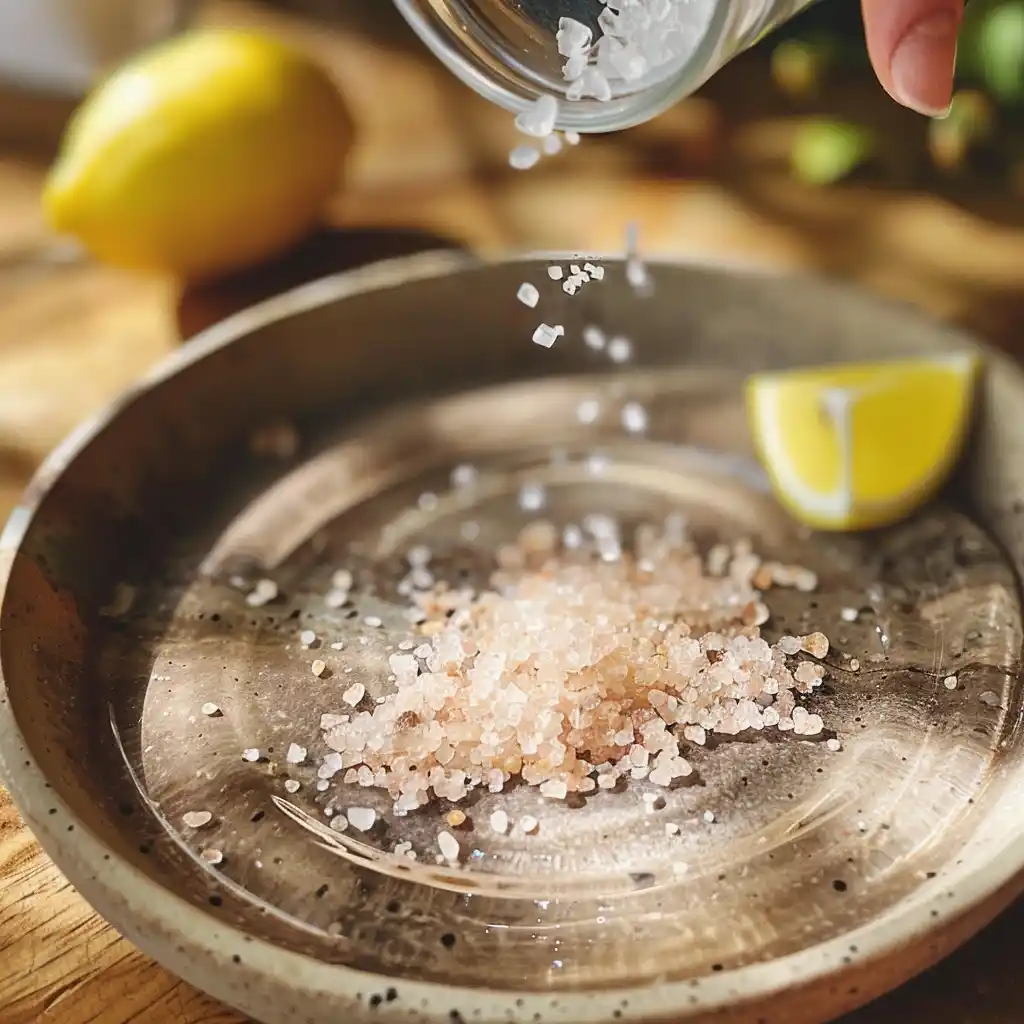
Some people prefer to prepare a jar of sole water in advance by filling a glass jar with pink salt and adding enough water to cover it. After letting it sit overnight, the solution becomes fully saturated. A teaspoon of this sole in a glass of water each night is gentle and easy to maintain.
| Type of Water | Amount of Pink Salt | When to Drink |
|---|---|---|
| Warm filtered water (8 oz) | 1/8 teaspoon | Before bed |
| Morning water (room temp) | 1/4 teaspoon | Upon waking (optional) |
| Sole solution (pre-mixed) | 1 teaspoon of solution in 8 oz water | Evening or morning |
The Role of Temperature and Timing
I find that warm water works best—it feels nurturing and helps the salt dissolve evenly. Drinking it about thirty minutes before bed helps my body settle. Others prefer taking it in the morning for hydration and clarity. There’s no strict rule, only the rhythm that feels most natural to you.
Listening to Your Body’s Feedback
If you’re new to this ritual, start small. Observe how your body responds over a few days. If you feel unusually thirsty, light-headed, or bloated, reduce the amount or skip a night. Your body is the best guide—it will always tell you when you’ve found your balance.
Looking for inspiration? Try the blue salt trick recipe for a refreshing twist on mineral-infused wellness.
How Much Pink Tibetan Salt to Add to Water
The Natural Origin of Its Color
Every time I open the jar of pink Tibetan salt, I still pause to admire its soft, rose-like hue. That color isn’t artificial—it’s a gift from the earth. The pink tone comes from iron oxide, the same mineral that colors clay and gives soil its reddish tint. This iron binds with salt crystals as they form under intense geological pressure over millions of years. The deeper the mine, the richer and darker the shade tends to be. So, each crystal tells a story—of ancient seas, slow earth movement, and quiet mineral evolution.
Trace Minerals and Their Gentle Influence
Pink Tibetan salt contains more than 80 trace minerals. Some of the key ones include:
| Mineral | Benefit (Traditional View) |
|---|---|
| Iron | Gives color, may support blood balance |
| Magnesium | Traditionally used to help relaxation |
| Calcium | Supports natural bone function |
| Potassium | Aids in hydration balance |
| Zinc | Associated with immune health |
These minerals are what set pink salt apart from refined white salt. They add not just flavor, but a touch of harmony to the body’s mineral needs. When I sprinkle a little over warm vegetables or stir it into my evening water, I like to imagine I’m bringing a trace of ancient oceans back into my day.
How Purity Affects Color
One of the lovely surprises I learned is that not all pink salts are equal. True pink Tibetan salt is usually less glossy than the commercial Himalayan versions. Its tone may range from pale blush to deep coral, depending on mineral balance and purity. The softer color often signals fewer impurities and less industrial processing—exactly what I look for when choosing ingredients that align with simple, natural living.
Symbolism and Energy in Tradition
In Tibetan and Himalayan cultures, the pink color is often seen as a symbol of grounding energy and heart-centered calm. Some use it during spiritual cleansing or home rituals, believing the salt’s hue carries warmth and positivity. Whether or not you share that belief, there’s something undeniably comforting about its natural beauty. For me, the act of pouring warm water over the delicate crystals each evening feels almost ceremonial—a way of saying thank you to the earth for its quiet gifts.
Don’t miss our salt and ice trick recipe for another refreshing salt-based tradition that uses contrast to restore balance.
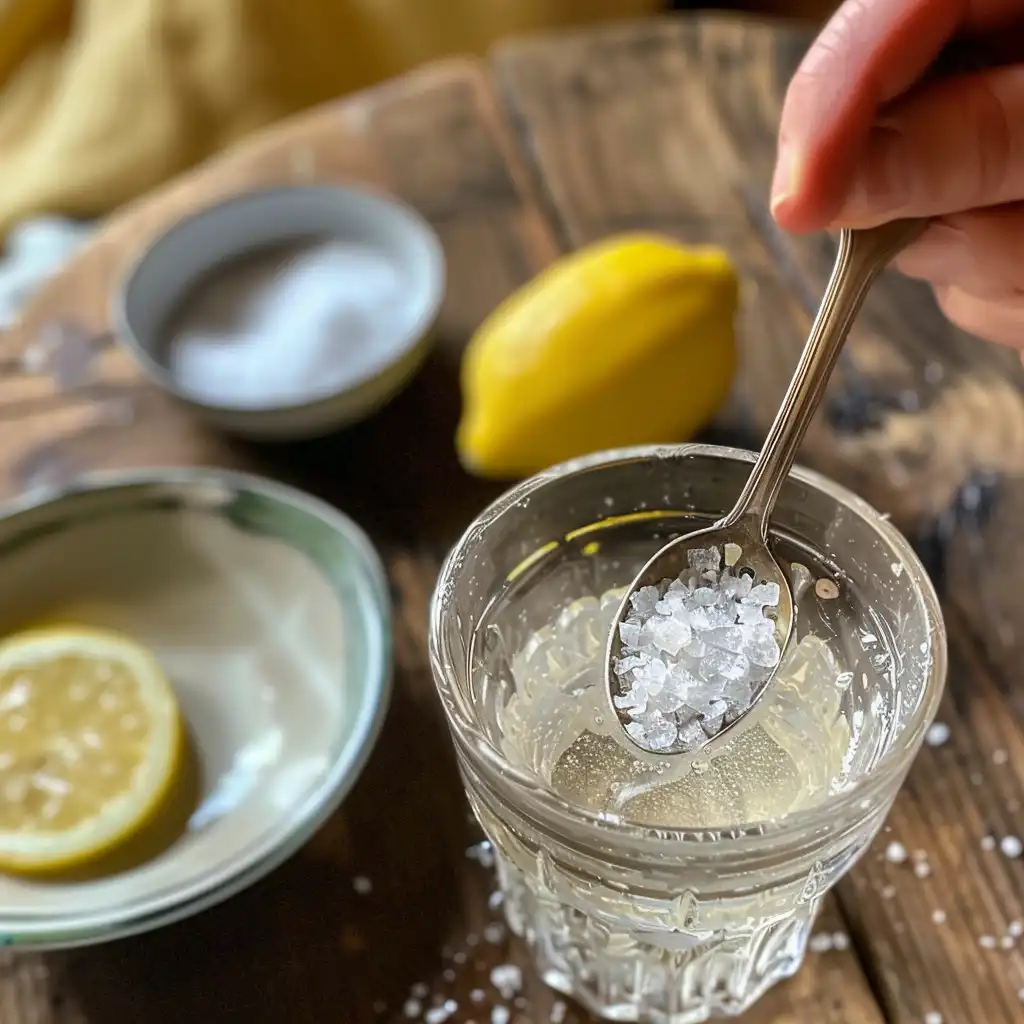
The Everyday Uses of Pink Tibetan Salt
In the Kitchen — A Flavor Beyond Ordinary Salt
When I first swapped regular table salt for pink Tibetan salt in my kitchen, I noticed how differently it behaved in cooking. Its flavor is softer, less sharp, almost floral. Sprinkled over warm vegetables or freshly sliced tomatoes, it adds a depth that feels almost nurturing. I often grind it coarsely for soups, salads, and roasted roots—it brings out the natural sweetness of food rather than overpowering it. Because it’s unrefined, pink Tibetan salt retains trace minerals that subtly change its taste and texture, making even simple dishes feel special.
| Food Type | How to Use Pink Tibetan Salt | Benefit |
|---|---|---|
| Soups & Stews | Add a pinch near the end of cooking | Retains minerals, softer flavor |
| Salads | Sprinkle lightly before serving | Brings out natural sweetness |
| Baked Vegetables | Use as a finishing salt | Adds gentle crunch |
| Fermented Foods | Use as brine base | Supports natural fermentation |
In Wellness and Beauty Rituals
Beyond the kitchen, pink Tibetan salt can be a peaceful addition to wellness rituals. I’ve made small sachets of salt to place near my bath for soaking—its minerals may support relaxation and ease tired muscles. Sometimes, I dissolve a handful in warm water and soak my feet after long garden walks; it’s grounding, almost meditative. In folk traditions, salt is also seen as cleansing for the energy of a home. I occasionally leave a bowl of pink salt by the window, believing it absorbs heavy energy and replaces it with calm.
As a Natural Air Cleanser
Some people keep salt lamps carved from pink Himalayan or Tibetan salt in their rooms, believing they may purify the air. While research is limited, I’ve found that the warm amber glow alone brings serenity. The light is soft, steady, and comforting—a reminder of stillness after dusk.
Bringing Salt Rituals Into Daily Life
A jar of pink Tibetan salt now sits permanently on my kitchen counter. Every time I reach for it, I’m reminded that health isn’t about extravagance but presence—being mindful in each stir, each taste, each breath. Incorporating this ancient mineral into my daily rhythm helps me pause, reflect, and reconnect with simple balance.
Discover more mindful kitchen rituals in the natural Zepbound recipe for weight loss.
The Myths and Truths About Pink Tibetan Salt
Common Misconceptions
Over the years, pink Tibetan salt has gathered both admiration and exaggeration. I’ve seen people online claim it can “detox the body overnight” or “replace medication”—claims that simply aren’t true. While it’s a beautiful, mineral-rich natural salt, it isn’t a miracle cure. The truth is simpler: it may support hydration, help maintain electrolyte balance, and add trace minerals to the diet—but it won’t cure illness or burn fat on its own. I always remind readers that true health isn’t found in one ingredient but in the small habits we keep day after day.
The Truth About “Detox” and Salt
Many people misunderstand what detox means. Our bodies already have wonderful systems—the liver, kidneys, and skin—that naturally filter waste. What pink Tibetan salt may do is gently assist hydration and digestion, supporting those organs in their natural work. Drinking salt water before bed isn’t a quick cleanse; it’s a mindful ritual that encourages balance and rest. Think of it as nourishment for your body’s natural rhythm, not a shortcut to purification.
Misleading Marketing and What to Watch For
With the growing popularity of Himalayan and Tibetan salts, many products are now colored artificially or mixed with additives. Authentic pink Tibetan salt should have a natural blush—never a bright, artificial hue. Its crystals may vary in size and shape, and the texture should feel slightly rough, not polished. Whenever I buy a new batch, I look for small producers who focus on natural sourcing. Real wellness begins with honesty, not labels.
| Claim | Truth |
|---|---|
| “Pink salt detoxes your body overnight.” | No—it may support hydration but not detox organs. |
| “It has no sodium.” | False—it contains sodium, though balanced with other minerals. |
| “All pink salts are the same.” | Not true—Tibetan salt has unique mineral patterns and texture. |
| “You can eat unlimited amounts safely.” | Incorrect—moderation is always essential. |
Returning to Simplicity
The beauty of pink Tibetan salt lies in its simplicity, not its promises. It reminds us that nature doesn’t need exaggeration to be healing. I often say, “Let your salt be your teacher.” It teaches moderation, patience, and appreciation for the small. When used with mindfulness, it becomes more than a seasoning—it becomes a moment of presence.
For more gentle and truthful wellness traditions, learn more about the honey trick recipe for memory loss.
FAQs About Pink Tibetan Salt
What is the salt water trick before bed?
The salt water trick before bed is a traditional wellness ritual where you mix a small pinch of pink Tibetan salt with warm filtered water and sip it slowly before sleep. This gentle drink may support hydration and relaxation after a long day. It’s not meant as a cleanse or medical treatment but as a calming nightly habit. Many find it helps them wind down and feel more at ease before bedtime.
Looking for inspiration? Try the pink salt trick recipe for weight loss or the salt and ice trick recipe for related wellness rituals that honor balance and simplicity.
Conclusion: Returning to the Simplicity of Pink Tibetan Salt
As I close my jar of pink Tibetan salt tonight, I think about how something so small—just a grain of mineral crystal—can hold such quiet wisdom. It doesn’t promise miracles or quick changes, yet over time, it gently reshapes the way I approach health. This salt has taught me to slow down, to listen to what my body needs, and to trust the calm that follows simplicity.
Using pink Tibetan salt isn’t just about minerals or flavor—it’s a practice in mindfulness. Whether you add it to warm water before bed, sprinkle it over a meal, or use it in a bath, the intention matters most. It’s an invitation to pause, breathe, and bring balance back into your day.
If you’re looking for natural ways to care for yourself, check out the blue salt trick recipe for a refreshing take on mineral balance, or discover great ideas like the bariatric seed ritual recipe for grounding nourishment.
And if you’d like to connect more, I often share my favorite slow-living rituals and gentle drink recipes on my Facebook page at facebook.com/profile.php?id=61574017187063 and my Pinterest board at pinterest.com/heartlyrecipes.
Disclaimer: This article is shared for informational purposes and personal experience only. It is not intended to replace medical advice. Please consult your healthcare provider before making dietary or health-related changes.
